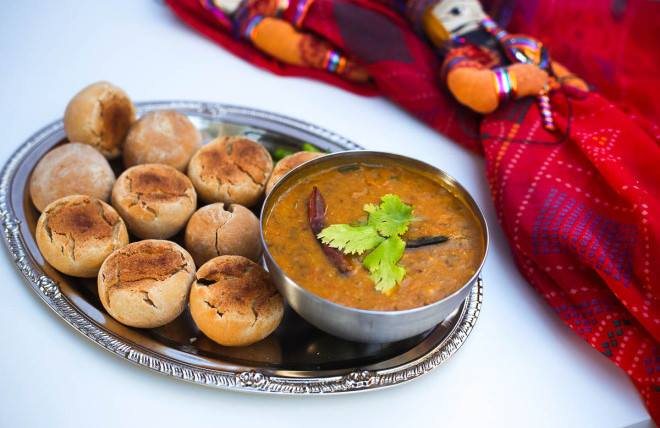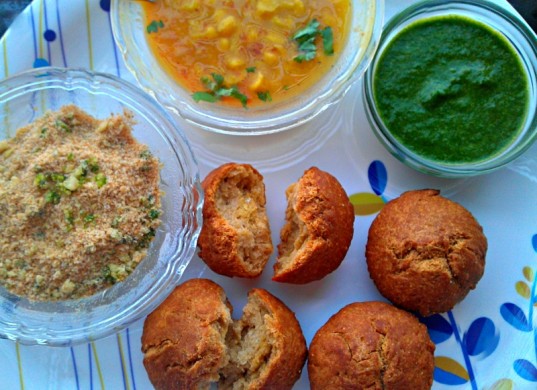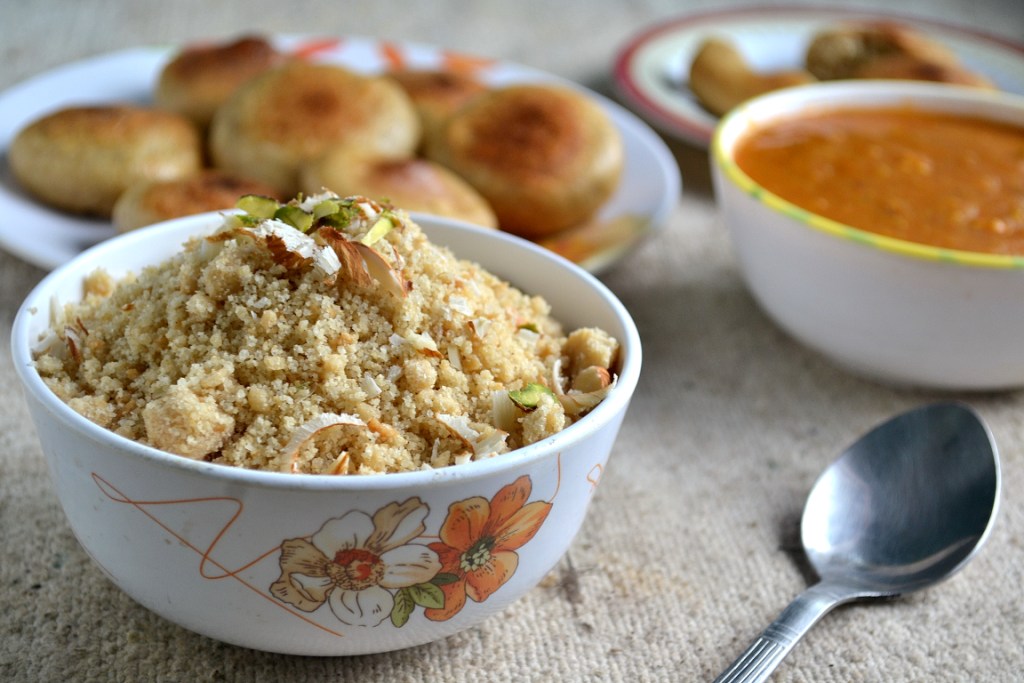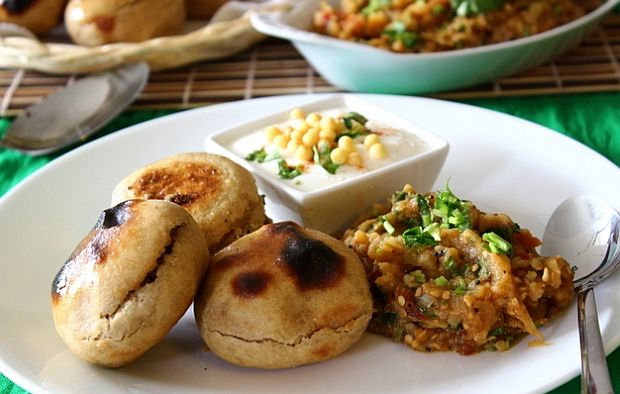TBI Food Secrets: The Fascinating History Behind Rajasthan’s Traditional Dish Dal Baati Churma
A famed culinary gem of Rajasthan, Dal Baati Churma is revered as much for its simplicity as for its scrumptious taste. This story traces the interesting origins of this delicious dish.

What Chole Bhature is to Punjab, Dal Baati Churma is to Rajasthan. A quintessential Rajasthani dish, this three-in-one treat (baked baati with spicy panchmel dal and sweet crumbly churma) is revered as much for its simplicity as for its delicious taste. While this culinary gem is famed for its wonderful taste, the fascinating story behind its origin is virtually unknown.
So how and where did Dal Baati Churma really originate? Many believe that the answer lies in the history of the kingdom of Mewar.

Photo Source
Baati (little doughballs made of wheat flour, ghee and milk) is believed to have originated during the time of Bappa Rawal – the founder of the kingdom of Mewar. Back then, the Rajputs were establishing their stronghold in the region and baati was their preferred war time meal.
It is believed that the Rajput soldiers would break the dough into chunks and leave it buried under thin layers of sand to bake under the sun. On their return from the battlefield, they world dig out the perfectly baked baatis that were then slathered with ghee and consumed with curd made from goat or camel milk.
Also Read: TBI Food Secrets: 18 Traditional Indian Breads That You Must Absolutely Try Out
It was later, when traders from the Gupta Empire settled in Mewar, that the combination of dal and baati became popular – panchmel dal was a much-loved favourite in the royal court of the Guptas. The panchmel dal is a simple and nuritious mix of five lentils – moong dal, chana dal, toor dal, masoor dal and urad dal – prepared with a fragrant tempering of cumin, cloves and other spices.
Churma, on the other hand, is believed to have been invented when a cook of Mewar’s Guhilot clan accidentally poured sugarcane juice into some baatis. Realising that it had made the baati softer, the women of the clan started dunking the battis in sweet water (made from sugarcane or jaggery) in an attempt to keep the baatis soft and fresh for their husbands. This eventually evolved into churma, a sweetened and cardamom-flavoured mix of crushed baati.

Photo Source
So, it was in desert kingdom of Mewar that this mouth-watering combination of sweet, spicy and bland bread originated. As the dish became popular throughout Rajasthan, each local dynasty added its own twist to the combination. And finally, with Akbar’s queen, Rani Jodha Bai, dal baati churma reached the Mughal court.
You May Like: The Story of Biryani: How This Exotic Dish Came, Saw and Conquered India!
The royal chefs of the Mughal court created their own versions of the dish, giving rise to bafla and kheech. A softer variation of the baati, bafla is a baati that has been boiled before being baked. Kheech is a kind of traditional porridge (similar to daliya) made from whole wheat as well as bajra (pearl millet).
There is a famous folk legend associated with kheech in Rajasthan. This it how it goes:
After being attacked by Rana Kumbha of Mewar, Rao Jodha (the founder of Jodhpur) was fleeing from Chittor when he stopped at a farmer’s house for food. He was served some freshly prepared traditional kheech by the farmer’s wife who was unaware of her guest’s royal identity. A hungry Rao Jodha put his finger right in the centre of the piping hot bowl, burning his fingers. Having witnessed this, the farmer’s wife chided,
“You are making the same mistake as our king (Rao Jodha). Kheech is hottest in the centre and coolest at the edge. So one should eat from there.”
It is believed that this is what prompted the King to stop worrying about recovering the central fort of Mandore and focus his attention on outlying forts, which he managed to win with ease. He later won back Mandore too.

Photo Source
Interestingly, at the time when baati was becoming increasingly popular in Rajasthani courts, another similar culinary gem was evolving in another part of the country. A specialty of the Bihari cuisine, litti was a staple dish in the Magadhan court for a long time.
Much like baati, litti needed very less water and could be baked in the sun without any utensils. It even had similar ingredients – it is made of wheat, ghee and water. However it is softer than baati and has deliciously spicy filling of sattu, a mixture of ground pulses and cereals

Photo Source
While litti was traditionally served with chokha (charred brinjals cooked with tomatoes, mashed potatoes, green chillies and onions), the combinations underwent many changes as each new ruler of the region had his own preferences. In Mughal court, litti was served with shorbas (rich creamy soups) and payas (a slow cooked spicy broth), while the Britishers preferred it with curry. However, it is the classic combination of litti chokha (believed to be a favourite of Rani Laxmi Bai) that has survived over the ages and that still fascinates foodies across the country.
Both litti chokha and dal baati churma are deceptively delicious. Keeping in mind their surprisingly similar appearance and taste, these two can perhaps be called culinary cousins, with litti being the spicier one!
Now that you know the fascinating history of Dal Baati Churma, don’t forget to try this delightful dish in its hometown, Rajasthan!
To make at home, get the recipe of Dal Baati Churma here.
Feature Image Source
Like this story? Have something to share? Email: contact@thebetterindia.
NEW! Log into www.gettbi.com to get positive news on Whatsapp.

Similar Story

8 Best Idli Places in Bengaluru Which Serve Extra Love For ‘Thatte Idlis’
Larger than the usual idlis and shaped like discs, the ‘thatte idlis’ of Bengaluru have a fan following of their own. Here are eight places in the city for idlis and other South Indian breakfast staples.
Read more >
If you found our stories insightful, informative, or even just enjoyable, we invite you to consider making a voluntary payment to support the work we do at The Better India. Your contribution helps us continue producing quality content that educates, inspires, and drives positive change.
Choose one of the payment options below for your contribution-
By paying for the stories you value, you directly contribute to sustaining our efforts focused on making a difference in the world. Together, let's ensure that impactful stories continue to be told and shared, enriching lives and communities alike.
Thank you for your support. Here are some frequently asked questions you might find helpful to know why you are contributing?


This story made me
-
97
-
121
-
89
-
167












